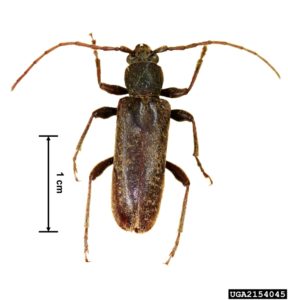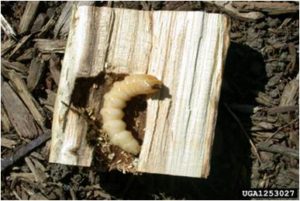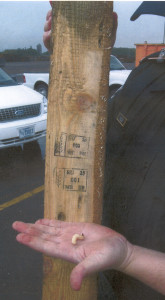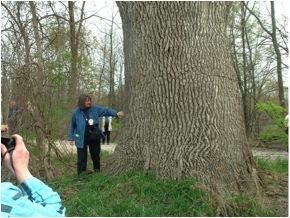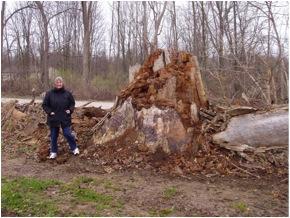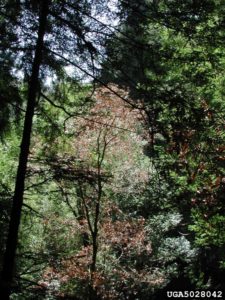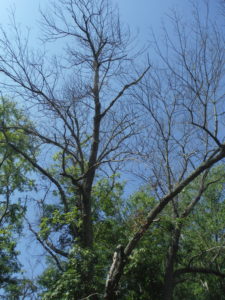Holly Raguza, Pennsylvania Department of Agriculture
I have not written previously about two insects that threaten fruit and forest trees in the U.S. – the spotted lanternfly (Lycorma delicatula) and the velvet longhorned beetle (Trichoferus campestris). APHIS has adopted strangely – and unexplained – different approaches to the two.
Spotted Lanternfly – Pennsylvania Jumps In; APHIS Provides the Funding
The spotted lanternfly (Lycorma delicatula) was first detected in southeast Pennsylvania in autumn 2014. It is native to China, India, and Vietnam. What was known then about its host range came from experience in Korea, where it had also been introduced. Officials were alarmed because the lanternfly is considered a pest of grapes and peaches – both are major crops in Pennsylvania (Spichiger Update; see reference below).
Currently, outbreaks of the spotted lanternfly are in 74 municipalities in six counties in the southeastern part of the Commonwealth – covering a total of 829 square miles. In the more than two years since its detection, the spotted lanternfly has not spread to the rest of the Commonwealth or to other states. Authorities therefore believe that the state’s quarantine is having an impact (Spichiger Update & pers. comm.).
Pennsylvania’s authorities believe the lanternfly utilizes about 80 species of plants, especially during the early stages of its development. A monitoring program managed by Dr. Gregory Setliff of Kutztown University (see reference below) has developed a list of 24 putative hosts – including maples, birches, hickories, dogwoods, beech, ash, walnuts, tulip tree, tupelo, sycamore, poplar, peaches and plums, oaks, willows, sassafras, basswood, and elms. Setliff also found that the lanternfly will penetrate into woodlands; it does not stay on the edges.
Adults strongly prefer the widespread invasive species tree of heaven (Ailanthus altissima). In fact, it might be necessary for adults to feed on Ailanthus before laying their eggs. However, oviposition can occur on not just a wide variety of plants but also nearly any hard surface (Spichiger).
Officials are optimistic that an approach using trap trees will eradicate the spotted lanternfly. They remove most Ailanthus, then apply a systemic pesticide to the remaining trees to kill adult lanternflies when they feed (Spichiger).
Fortunately, this insect is conspicuous. As a result, 90% of citizen reports of sightings have proven to be accurate (Spichiger). This contrasts greatly with phytosanitary officials’ experience with Asian longhorned beetle, emerald ash borer, and other tree-killing pests.
Scientists in both Pennsylvania and China are looking for natural enemies.
The entire program in Pennsylvania has been funded through a series of Farm Bill grants from APHIS (Spechiger pers. comm.). These began in FY2016, right after the 2014 detection. By FY2017, Farm bill funding totaled nearly $2 million; it went to a myriad of entities to: study lanternfly lifecycles and host preferences; find possible biocontrol agents and chemical treatments; and – especially – for outreach and education. Nearly $1.6 million of these funds went to state agencies in Pennsylvania.
Velvet Longhorned Beetle — States Limp Along; APHIS Support Minimal
Christopher Pierce, Bugwood
In contrast to the spotted laternfly, populations of the velvet longhorned beetle (VLB Trichoferus campestris) appear to be more long-standing and more widely spread. It was first found in 2010 in Utah. Now, it has been detected 15 separate times in Quebec and 11 U.S. states, according to Wu et al. 2017 and websites listed below. States specifically mentioned by sources include Illinois, Minnesota, New Jersey, New York, Ohio, Pennsylvania, and Rhode Island. Most are of single or a few beetles – although detections are sometimes repeated over several years – e.g., in Minnesota.
In contrast, the outbreak in Utah appears to be established and growing. The number of beetles detected has exploded from 4 in 2010 to 1,863 in 2015 .
Like so many other invaders, this beetle is known to be native to East and Central Asia.
The host range is still being studied. Hosts are thought to include more than 40 genera, including apple; cherry and peach; maple; birch; mulberry and paper mulberry; beech; ash; honey locust; mountain ash; willow; and cut wood of spruce and pine.
Like other woodborers, the velvet longhorned beetle has often been intercepted in wood packaging (see my earlier blogs. There have been 29 interceptions of the Trichferous genus over 3 years. Some of the newly established populations – such as Utah’s outbreak – are tied to specific shipments in which wood packaging was insect-infested (Wu et al. 2017).
VLB has also been detected in imported rustic furniture – probably because the beetle is apparently much more tolerant of tunneling in dry wood than other Cerambycids. In some pieces, insect activity was not detected until 18 months after the furniture was purchased. In 2016 a Minnesota homeowner discovered a beetle emerging from bark-covered furniture that she had purchased more than a year earlier. Furniture from this shipment was shipped to at least 10 other states [Mark Abrahamson, Minnesota Department of Agriculture, pers. comm. February 16, 2017]. The Minnesota Department of Agriculture, APHIS, and other State departments of Agriculture are working with the furniture seller to recover and destroy all infested furniture.
Detection of the velvet longhorned beetle has been hampered by the absence of a good lure for traps. Dr. Ann Ray of Xavier University in Ohio has isolated and identified a possible lure but needs another field season to determine the right amount of pheromone for each trap. While Dr. Ray’s earlier work had been funded by APHIS through its Section 10007 program, APHIS chose not to fund the final stage of testing in the FY2017 Farm Bill grant program. Indeed, no VLB programs were funded this year.
This contrasts sharply with APHIS’ continued engagement with the spotted lanternfly.
The extent of damage to fruit trees caused by the velvet longhorned beetle has been difficult to determine (Ray; see reference below). Perhaps for this reason, APHIS has not adopted an official stance on whether the beetle is “established” in the United States. Thus, five years after the insect was detected for a second year in Utah, the agency cannot make up its mind how great the threat is and what the agency’s response should be.
If the velvet longhorned beetle turns out to be highly damaging, eradicating it will have become increasingly difficult during the years that APHIS has pondered what to do.
See also http://ag.utah.gov/documents/Insect_Velvet_Longhorn_Beetle.pdf
SOURCES
Ray, Annie. Evaluation of lure and trap design for monitoring the velvet longhorned beetle Trichoferus campestris. XXVIII USDA Interagnecy Research Forum on Invasive Species January 10 -13, 2017.
Setliff, Gregory P. Investigating the host range of the spotted lanternfly (Lycorma delicatula) in southeastern Pennsylvania. XXVIII USDA Interagnecy Research Forum on Invasive Species January 10 -13, 2017.
Spichiger, Sven-Erik. Pennsylvania Department of Agriculture. Update on spotted lanternfly program in Pennsylvania. XXVIII USDA Interagnecy Research Forum on Invasive Species January 10 -13, 2017.
Wu,Y., N.F. Trepanowski, J.J. Molongoski, P.F. Reagel, S.W. Lingafelter, H. Nadel1, S.W. Myers & A.M. Ray. 2017. Identification of wood-boring beetles (Cerambycidae and Buprestidae) intercepted in trade-associated solid wood packaging material using DNA barcoding and morphology
We welcome comments that supplement or correct factual information, suggest new approaches, or promote thoughtful consideration. We post comments that disagree with us — but not those we judge to be not civil or inflammatory.
Posted by Faith Campbell

